Recent Water Damage Posts
The Three Types of Water Damage Every Homeowner Should Know
10/15/2024 (Permalink)
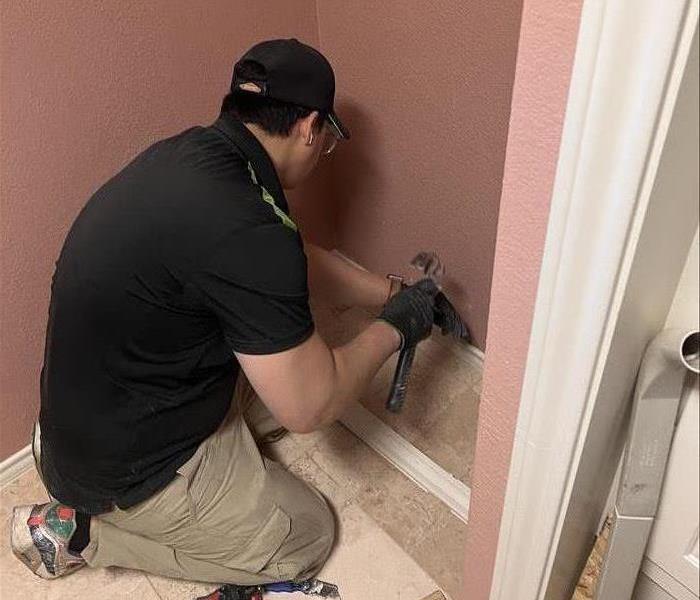 Whether you’re dealing with clean, grey, or black water, SERVPRO of East Arlington has the expertise and equipment to handle any situation.
Whether you’re dealing with clean, grey, or black water, SERVPRO of East Arlington has the expertise and equipment to handle any situation.
Water damage is a common problem that homeowners in the Arlington area face, and it can come from various sources. However, not all water damage is the same. Understanding the different types of water damage—clean, grey, and black water—is crucial for determining the appropriate response and ensuring your home is restored properly. In this blog, we’ll break down the three main categories of water damage, providing tips and insights to help you understand what each type means and how to handle it.
What Are the Types of Water Damage?
Water damage is categorized into three main types based on the level of contamination. Knowing which category you’re dealing with is important because it influences the cleanup process and the precautions you should take.
1. Clean Water Damage
Clean water damage is the least severe type and comes from sources that do not pose a significant risk of contamination. This type of water is free of harmful microbes and chemicals. Common sources of clean water damage include:
- Broken pipes or water supply lines
- Overflowing sinks or bathtubs with clean water
- Rainwater or melting ice and snow
Because clean water is uncontaminated, it is the easiest type of water damage to clean up. However, if left unattended for more than 24 to 48 hours, clean water can degrade into grey water due to microbial growth, making the damage more complicated to take care of.
2. Grey Water Damage
Grey water damage is a step up in severity. This type of water damage involves water that has been used and is now contaminated with chemicals, detergents, or microorganisms. Grey water does not contain fecal matter but can still cause considerable damage if not properly managed. Common sources of grey water damage include:
- Washing machine overflows
- Dishwasher leaks
- Toilet overflows without solid waste
- Sump pump failures
Grey water may contain bacteria and other microbes, so it requires more thorough cleaning and sanitizing than clean water. It is advisable to call a professional restoration company like SERVPRO of East Arlington to ensure all contaminated materials are removed and the affected area is sanitized to prevent further damage.
3. Black Water Damage
Black water damage is the most severe and dangerous type. It involves water that is highly contaminated and may contain harmful bacteria, chemicals, and pathogens. Black water typically comes from:
- Sewage backups
- Flooding from rivers or streams
- Overflowing toilets with fecal matter
- Long-standing water that has microbial growth
Black water damage poses a significant risk to humans and pets and requires immediate and comprehensive remediation. Failure to address black water damage quickly can result in severe property damage. Materials that have been contaminated, such as carpeting, insulation, and drywall, usually need to be removed and replaced.
How to Handle Different Types of Water Damage
When dealing with water damage, it's important to identify the type of water involved to take the appropriate steps. Here’s a quick guide:
- Clean Water: Quickly remove water with mops or wet vacuums and dry the area using fans and dehumidifiers. Monitor for any signs of deterioration in water quality.
- Grey Water: Wear gloves and protective clothing, and use a disinfectant during cleanup. Remove and replace any affected porous materials like carpet or furniture upholstery.
- Black Water: Immediately evacuate the affected area and contact a professional water damage restoration company like SERVPRO®. Do not attempt to clean up black water damage on your own, as it requires specialized equipment and expertise.
Trust SERVPRO for Your Water Damage Restoration Needs
By knowing the different types of water damage and the appropriate steps to take, you can better protect your home and valuables from the unexpected. Remember, acting fast and knowing what you’re dealing with are key to a successful restoration.
Whether you’re dealing with clean, grey, or black water, SERVPRO of East Arlington has the expertise and equipment to handle any situation. Contact us today!
Why Smart Home Technology Can Be A Lifesaver Against Water Damage
6/12/2024 (Permalink)
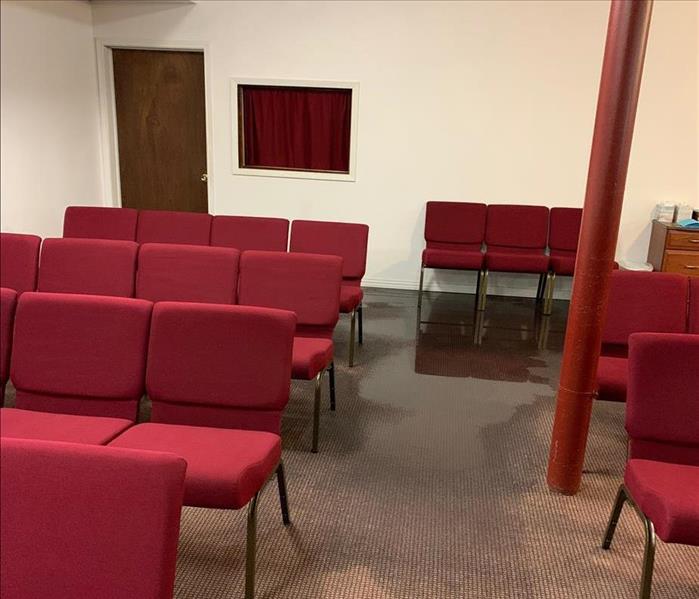 Incorporating smart home technology into your property can be a game-changer when it comes to protecting against water damage.
Incorporating smart home technology into your property can be a game-changer when it comes to protecting against water damage.
Technology has revolutionized the way we live, offering convenience, efficiency, and even safety enhancements. One area where technological advancements shine is in home protection, particularly against the threat of water damage. Smart home technology has emerged as a lifesaver, providing homeowners with innovative solutions to prevent water damage and mitigate its impact. Let's explore how integrating smart home technology into your property can help you protect your home against water-related disasters.
Smart Leak Detection Systems: Early Warning Against Water Intrusion
One of the most significant advantages of smart home technology is its ability to detect water leaks early, often before they escalate into major problems. Smart leak detection systems use sensors placed in key areas vulnerable to water damage, such as near appliances, under sinks, and around water heaters. These sensors continuously monitor moisture levels and can alert homeowners via smartphone notifications at the first sign of a leak. By providing early warning, smart leak detection systems empower homeowners to take immediate action to address the issue, potentially averting costly water damage repairs.
Wi-Fi Connected Water Shut-Off Valves: Instant Response to Emergencies
In the event of a detected leak, smart home technology offers another layer of protection with Wi-Fi connected water shut-off valves. These valves can automatically turn off the water supply to the affected area, preventing further water intrusion and minimizing damage. Additionally, homeowners can remotely control these valves via smartphone apps, allowing them to shut off the water supply from anywhere, even if they're away from home. This capability provides peace of mind and enables swift action in emergency situations, reducing the risk of extensive water damage.
Moisture-Sensing Smart Appliances: Proactive Defense Against Water Damage
Another innovative application of smart home technology is the integration of moisture-sensing capabilities into household appliances, such as washing machines, dishwashers, and refrigerators. These appliances use advanced sensors to detect abnormal levels of moisture, indicating potential leaks or malfunctions. Upon detection, these appliances can automatically pause their operations and alert homeowners to the issue, preventing water damage before it occurs. By proactively identifying and addressing moisture-related issues, smart appliances help homeowners avoid costly repairs and property damage.
Smart Home Monitoring Systems: Comprehensive Oversight of Your Property
To provide homeowners with comprehensive oversight of their property, smart home monitoring systems offer integrated solutions for monitoring various environmental factors, including temperature, humidity, and moisture levels. These systems use sensors placed throughout the home to continuously track environmental conditions and identify anomalies that may indicate water damage risks. With real-time alerts and data visualization features, homeowners can stay informed about their property's condition and take proactive measures to prevent water damage.
Leveraging Smart Home Technology for Water Damage Prevention
Incorporating smart home technology into your property can be a game-changer when it comes to protecting against water damage. From early leak detection to automated shut-off valves and moisture-sensing appliances, these innovative solutions empower homeowners to take proactive steps in preventing water-related disasters. By investing in smart home technology, you not only enhance your property's safety and security but also gain invaluable peace of mind knowing that your home is equipped to handle potential water damage threats.
Drastic Results from Water Damage to Your Texas House
4/21/2023 (Permalink)
One of the worst things that a homeowner can find themselves grappling with is a flood. In the aftermath of a flood, the property becomes susceptible to extensive water damage that can adversely impact your home. Water damage becomes progressively worse with each passing minute, and can give rise to the following problems:
- mold and mildew proliferation in your walls, furnishings, and carpets
- the growth of microorganisms that cause rotting in wood and fabric
- odors that become progressively worse/permanent
- the drywall becomes warped, soaked, and unusable
- wood and furniture become malformed and starts to smell
- metal rusts and starts to tarnish
Once these problems begin to surface, your insurance claim will often rise in cost. Additionally, your chance of recovering your home and restoring its original value can decrease drastically. It's also important to note that water damage can make your home difficult or impossible to live in if fungi begin to grow. The fungi show up as black or green mold and can appear wherever moisture or water has accumulated. More problems can surface including buckling floors, wooden door casings that swell up, wallpaper that peels, and adhesives that lose their bond with ceramic tile. Some other challenges that can occur include the staining of fabric, failure of electronic components, and peeling of paint. Home occupants are also at risk of contaminants in the water and air. Finally, exposure to contaminants can pose a variety of health effects.
Conclusion
The many results from water damage can hurt your Texas home. However, you can limit initial damage to your home by immediately calling in a water damage restoration company such as SERVPRO. The rapid execution of the water removal process helps protect the health of your household members from deteriorating. By contracting such a professional team of water damage specialists, the technicians immediately attack and quickly arrest mold growth before it becomes a serious, health-compromising issue in your home. Additionally, SERVPRO can offer a wealth of other cleanup services that help restore your Sango residential property to its previous condition. You can then resume living in it without fear or anxiety. With extensive industry experience, we know how nerve-wracking dealing with water damage can be. And that's why we work with experience and excellence to eliminate all issues that negatively impact your abode.
Locally Owned and Operated
We live and work in Texas too; we might even be neighbors. As a locally owned and operated business, SERVPRO of East Arlington is close by and ready to respond to your water or flood damage emergency. We are proud to be an active member of the Sango community and want to do our part to make our community the best it can be.
We know that water and flooding emergencies can happen any time, so we’re ready 24 hours a day, 7 days a week – including holidays. Call us today!
Floods Happen, Here's What to Expect
3/27/2022 (Permalink)
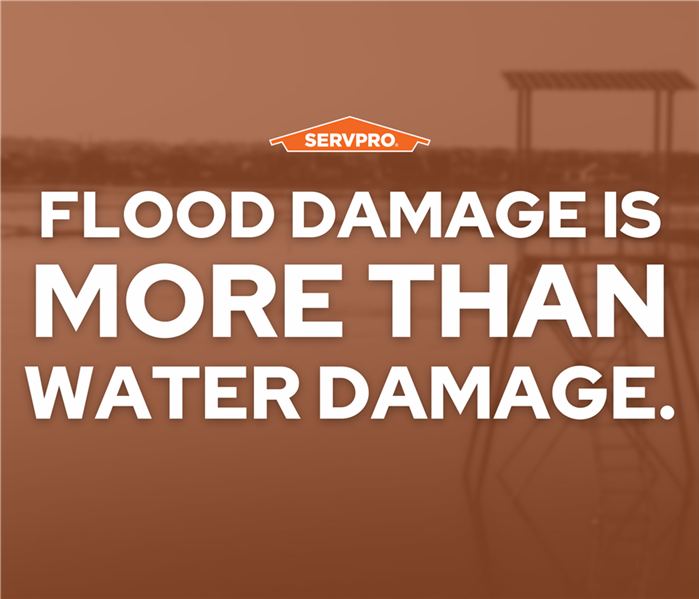 Floods happen. Call SERVPRO of East Arlington for a free estimate at (682) 708-1001.
Floods happen. Call SERVPRO of East Arlington for a free estimate at (682) 708-1001.
An Unexpected Flood, Now What?
Unless a house is in a floodplain, it might be unexpected that a creek would rise to flood levels, especially if it has never flooded before. However, sometimes it does and the house becomes a muddy mess of debris, water, and extensive damage. Moving homes might be the first thought to come to mind. For others, repairing the home and continuing to live in their house is the only option.
Flood damage is more than just the standing water. It's ruined clothes, toys, and keepsakes; it’s washed away memories, financial troubles, anxiety, and uncertainty. SERVPRO understands that because we handle disasters, damages, and people going through hardships—daily. We try to help you in every way we can. Part of that help comes in the form of disaster cleanup. We work with you and your insurance to make sure you can get back into your home as soon as possible.
Water in the home or business is just the start of the problems. Without proper clean-up and sanitizing, mold can grow, floor damage can be permanent, and drywall can be ruined. It is imperative to start the restoration process quickly in order to help limit the extent of damage and mounting costs.
What To Expect
Water cleanups begin with bringing in equipment to extract the water in the home. Pumps and specialized vacuums are used to suck up the water. Restoration is a process. Once the puddles have been cleared, the next step will begin. The water damage will be on the walls, floors, and furnishings. Drying is imperative to help stop the damage and to prevent mold from growing.
Fans, dehumidifiers, and other equipment will be brought in to help dry out the water in walls and moisture from furnishings and floors. Thoroughly drying water in the home will save thousands of dollars’ worth of damage later. Sanitation of anything that touched the potentially hazardous floodwater and odor elimination is next.
After the restoration process of water cleanup, drying, sanitizing, and odor elimination, there is still one last step in the water damage mitigation process —repairs. The food waters have the potential to damage anything in came in contact with. The drywall may need to be replaced. Electrical outlets and wiring should be checked and fixed. Water in a business may have warped sub-flooring, damaged floor joists, and wrecked major appliances.
Professionals who know how to deal with the devastation left behind are the best option for quick, safe, no hassle restoration. Since professional water damage restoration companies have the equipment and training to handle cleaning, drying, and even rebuilding homes and businesses, they should be the first choice for water mitigation.
Floods happen. Call SERVPRO of East Arlington for a free estimate at (682) 708-1001.
Fast Water Cleanup to Avoid Secondary Damages
3/27/2022 (Permalink)
Avoid Secondary Damages
In the aftermath of a flood, property and contents become susceptible to extensive water damage that can adversely impact your home. Water damage is different from other types of property damage in that it becomes progressively worse with each passing minute. Water seeps into objects until saturation, so the quicker a professional is able to get to the site and clean up, the less damage incurred, essentially. Water damage also has secondary effects that can be avoided with proper, thorough water damage cleanup:
Floodwater Secondary Damages
- Mold and mildew proliferation in walls, furnishings, and carpets
- Growth of microorganisms that cause rotting in wood and fabric.
- Odors that become progressively worse or permanent
- Warped, soaked, unusable drywall
- Malformed, smelly wood and furniture
- Tarnished and rusted metal
- Electronic components become waterlogged and fail
As these problems begin to surface, the chance of recovering your home and restoring its original value can decrease drastically.
Water Seeps Into Porous Materials
More problems can surface from water seeping into porous surfaces. Some of these problems manifest in the staining of fabric, buckling of floors, swelling of wooden door casings—sometimes causing doors to not fit in their frames, peeling wallpaper or paint, and adhesives that lose their bond with ceramic tile.
Why a Professional?
Property, contents, and home occupants are at risk of contaminants in the water and air after a flood. Exposure to contaminants can pose a variety of health effects. However, you can limit initial damage to your home and health by immediately calling in a water damage restoration company such as SERVPRO. The rapid execution of the water removal process helps protect the health of your household members from deteriorating.
A professional team of technicians quickly attacks the source of flooding and its secondary damages before any of it becomes a serious, health-compromising issue in your home.
Additionally, SERVPRO can offer a wealth of other cleanup services that help restore your Texas residential property to its preloss condition. You can then resume living in it without fear or anxiety. With extensive industry experience, we know how to take a nerve-wracking water situation and make it, “Like it never even happened.” And that's why we work with experience and excellence to eliminate all issues that negatively impact your abode.
Locally Owned and Operated
We live and work in Texas too; we might even be neighbors. As a locally owned and operated business, SERVPRO of East Arlington is close by and ready to respond to your water or flood damage emergency. We are proud to be an active member of the community and want to do our part to make our community the best it can be.
We know that water and flooding emergencies can happen any time, so we’re ready 24 hours a day, 7 days a week – including holidays. Call Us Today – (682) 708-1001.
Preventing Water Damage on Vacation
3/27/2022 (Permalink)
7 Steps to Preventing Water Damage While Away
According to a study done by the Insurance Institute, homeowners' highest insurance claims are water damage. Leaky or busted pipes and appliances cause millions of dollars in damage during freezing weather and storms. Leaky pipes don't take a vacation when you do and can burst, generating hundreds of dollars of repairs. Prevent water damage while your on vacation by using this checklist:
Step 1. Check for Leaks Before Going on Vacation
Check pipes under your sinks and the water heater for any rust, cracks, or damage. You should check the seals by your windows to make sure there are no cracks. Additionally, check the exterior of your house and see the condition of your roof shingles. If any show damage, getting them replaced before leaving for vacation is a good idea.
Step 2. Inspect Your Major Appliances
You must inspect the hoses connected to essential appliances in your home, such as dishwashers, washers/dryers, and refrigerators.
Step 3. Clear Out Your Gutters
Make sure to get any debris out of your rain gutters before leaving for vacation. This way, you won't have any blockages that can cause overflows which can lead to foundation problems and water damages while you're away.
Step 4. Inspect Your Sump Pump
Make sure it is in good condition and clear any debris from clogging the pit. Run a few tests, listen to the sounds it makes, and ensure that the pump's water is going outside. Install a battery-powered backup in case there is a power outage while you're away.
Step 5. Insulate Exposed Pipes
If you plan on being away from your home during the winter, it can be a good idea to insulate any exposed pipes. This will prevent them from freezing while you are away.
Step 6. Get Someone to Check on Your Home
Call a friend or hire a professional house sitter to check on your home every week while you are gone. Instruct them to ensure that the heat is always on if your vacation is during the winter. Also, show them where the water main is in case of an emergency.
Step 7. Ease Your Mind By Turning Off the Water
Lastly, if you cannot find someone to check on your home, you should turn off the water main. Drain the pipes so that they do not freeze or burst during the colder months. To do this, run the water and flush your toilet after you turn off the water. Open the cabinets under your sink to let the warm air surround the pipes.
If you experience water damage while you are away from your home, contact SERVPRO of Tampa Southeast as soon as possible at (682) 708-1001.
4 Easy Tips to Prevent Water Damage
3/27/2022 (Permalink)
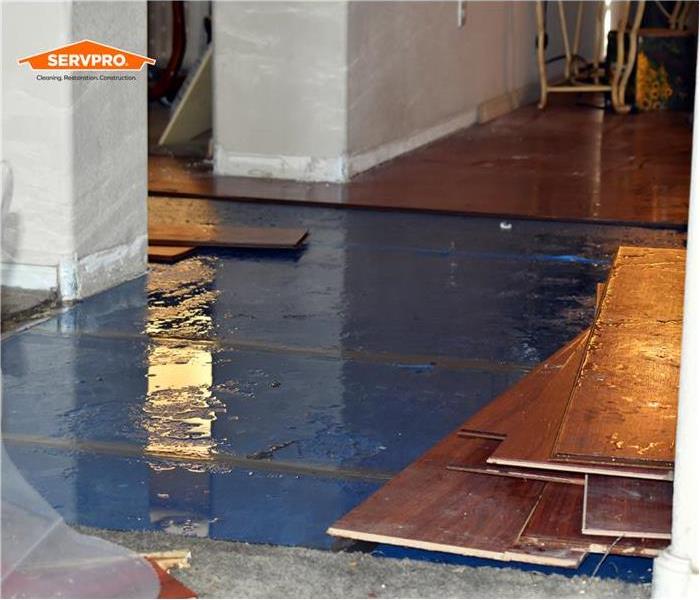 We’re ready 24/7 – including holidays to help your commercial business recover from sprinkler water damages.
We’re ready 24/7 – including holidays to help your commercial business recover from sprinkler water damages.
Water damage is one of the most costly disasters your home or business can experience. The Insurance Information Institute estimates that billions are spent on water damage each year. View these suggestions from SERVPRO of East Arlington for preventing water damage.
Be careful where you plant.
Some plants and trees, like weeping willows, have pretty invasive roots. If you’re not careful, they’ll grow right into your sprinkler system, drainage field, pipes, and septic tanks. Plan before you plant to keep roots away from any water lines.
Clean out roof gutters.
On a rainy day, a clogged gutter can send water spilling into your home’s foundation, through the roof, or down to your basement. That could cause some severe water damage So next time you’re doing some seasonal cleaning, make sure those gutters are clean. If your gutters are too high, be safe, and get a professional to check them.
Use a drain snake instead of unclogging chemicals.
Most folks don’t realize these chemicals are eating away at their pipes (and they might not be too good for you either). If you rely on them a lot, you could be setting yourself up for leaks. That’s why owning a drain snake is an excellent solution to clear away clogs. They’re pretty inexpensive, you can get them at your local hardware store, and they can cut through most any clog you’ll have without damaging pipes or making your eyes red and teary.
Never pour grease down your sink.
It doesn’t matter if you flush it with hot or cold water; grease can still cling to your pipes and could even cause some severe damage and blockage. The safest thing to do is pour your grease into an empty can and either let it sit or put it in the refrigerator. Once it hardens, you can toss it in the trash and get rid of it. Done and done. However, we know that water and flooding emergencies can happen any time, so we’re ready 24 hours a day, 7 days a week – including holidays. Contact us at (682) 708-1001.
Why East Arlington Fabrication Plant Calls SERVPRO to Extract Water
3/13/2022 (Permalink)
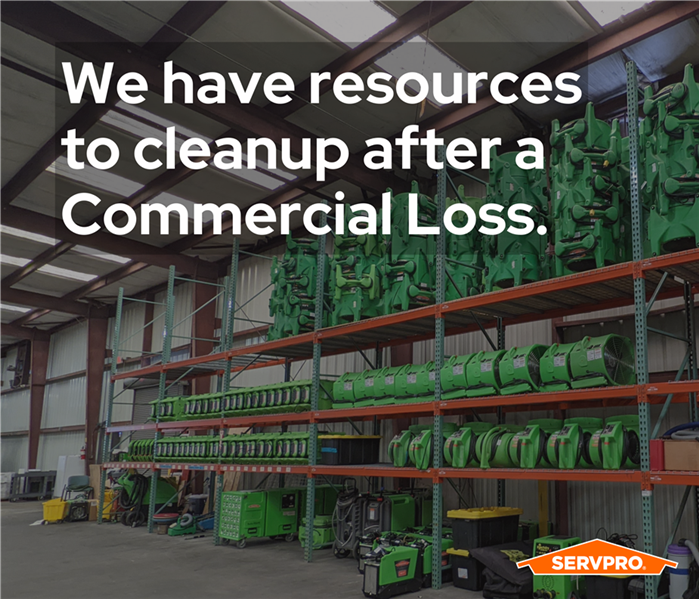 We are proud to help businesses in this community with commercial water removal methods continue serving the public.
We are proud to help businesses in this community with commercial water removal methods continue serving the public.
Flood water and storm damage events at commercial properties often involve numerous issues that require a knowledgeable and flexible response. Whether we are dealing with a relatively small water cleanup scenario or a large-scale event, SERVPRO of East Arlington quickly assesses each unique situation and isolates the damaged area for cleanup. In many instances, normal operations can continue in a temporary space while we restore your facility and make it, “Like it never even happened.”
Unique Challenges of Restoring Commercial Property
Our professionals at SERVPRO are trained to be mindful of legal and environmental concerns and strive to fully restore the damaged area while working within your budgetary constraints. We understand that every hour spent cleaning up is an hour of lost revenue and productivity.
Why Arlington Fabrication Plant Calls SERVPRO to Extract Water
Once a factory or other assembly plant sustains water loss, drying the area to protect employee health and safety, machinery, and productivity is a priority. Drains are a simple solution to water removal or rerouting, but they can only do so much when massive amounts of water are present in multiple areas. For instance, overhead water sources can ruin machines and other equipment by forming pools of water in the depressions of equipment.
Water Extraction
Removing the water from where it would otherwise remain trapped prevents corrosion of metal and keeps microbial infestations from developing. When your equipment retains water, we suction it out with specialty tools like water and other material extractors, helping ensure that employees can continue their jobs with little interruption from us. Then, if the machinery's maintenance instructions call for it, we will even wipe machines with oil to prevent rust and protect equipment from possible problems.
SERVPRO Equipment Enhances Air Quality
Air movers help us keep moisture from condensing on surfaces and direct water vapor toward desiccation machines. These machines draw moisture from the air and release dry, filtered air back into the area we are treating. This cycle cleans and dries the air.
Using our various machines and tools, we protect your equipment and building from harm. At SERVPRO, we are proud to help businesses in this community with commercial water removal methods continue serving the public. We want to ensure businesses stay afloat, operating, and contributing to the local economy; part of the way we do that is by getting involved to mitigate a storm or water disaster as soon as we can. Call us today to schedule a free estimate, (682) 708-1001. We are also available 24 hours for emergency service.
4 Things to Know About Standing Flood Water
3/13/2022 (Permalink)
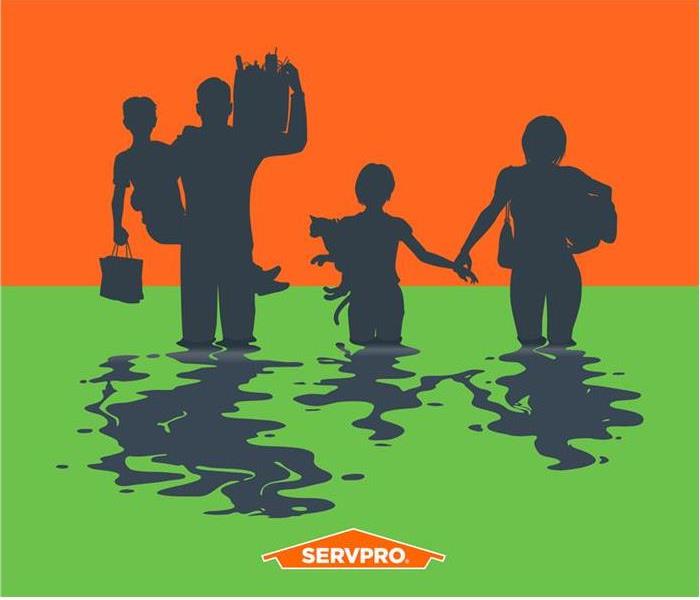 Our professional team will help you every step of the way. We really are Here To Help®.
Our professional team will help you every step of the way. We really are Here To Help®.
After a flood, you may wonder what to do next. It's normal to feel lost, confused and stressed after a flood impacts your area. How do you prepare for water damage or contaminants in black water? Here are four aspects of standing flood water you should know about.
1. Water Can Be Electrically Charged
Some overflow waters can be electrically charged. If there is working power in your home, you need to take the utmost care to ensure the water isn’t pulsing with electricity. When it comes time to have flood water restoration professionals help you, your safest option is to turn off all power until you or they have finished cleanup.
2. Pathogenic Contamination
Blackwater is a major category of consideration for standing water, particularly after a backed-up sewer or storm. This floodwater occurs after 24 hours and is considered to be full of pathogenic contaminants. This water can be full of garbage, mold, and even sewage.
3. Look Out For Mold Growth
Mold can grow in as little as 24 hours and as late as 72 hours after the water has been stagnant. Warm, moist areas tend to be perfect for mold growth. After a flood, one of the most common types of damage people have to deal with is the mold that grows on everything from furniture and other items in the house—to walls themselves.
4. Get That Water Out
Removing the water should always be the first step when it comes to cleanup. It’s essential to make sure the black water is taken out as soon as possible before it ends up further damaging your home. Never let water sit in your home; use a professional to help clean it up.
The damage caused by a storm can be intense, and it can be challenging to know which steps to take when you have extensive water damage. You don't have to go through this process alone. Call SERVPRO of East Arlington for additional information regarding storm damage. Our professional team will help you every step of the way. We really are Here To Help®.
4 Easy Tips to Prevent Water Damage
1/15/2021 (Permalink)
With the school year coming to an end, this means kids will be “flooding” into homes this summer. View these suggestions from SERVPRO of East Arlington for preventing water damage while your kids are home.
1. Be careful where you plant.
Some plants and trees, like weeping willows, have pretty invasive roots. If you’re not careful, they’ll grow right into your sprinkler system, drainage field, pipes, and septic tanks. Plan before you plant to keep roots away from any water lines.
2. Clean out roof gutters.
On a rainy day, a clogged gutter can send water spilling into your home’s foundation, through the roof, or down to your basement. That could cause some severe water damage So next time you’re doing some seasonal cleaning, make sure those gutters are clean. If your gutters are too high, be safe, and get a professional to check them.
3. Use a drain snake instead of unclogging chemicals.
Most folks don’t realize these chemicals are eating away at their pipes (and they might not be too good for you either). If you rely on them a lot, you could be setting yourself up for leaks. That’s why owning a drain snake is an excellent solution to clear away clogs. They’re pretty inexpensive, you can get them at your local hardware store, and they can cut through most any clog you’ll have without damaging pipes or making your eyes red and teary.
4. Never pour grease down your sink.
It doesn’t matter if you flush it with hot or cold water; grease can still cling to your pipes and could even cause some severe damage and blockage. The safest thing to do is pour your grease in an empty can and either let it sit or put it in the refrigerator. Once it hardens, you can toss it in the trash and get rid of it. Done and done. However, we know that water and flooding emergencies can happen any time, so we’re ready 24 hours a day, 7 days a week – including holidays.
Freezing Temps = Freezing Pipes
1/15/2021 (Permalink)
Now that winter is finally here, there’s bursting pipes everywhere!
As temperatures drop below freezing, water pipes both at your home and your workplace run the risk of freezing and potentially bursting. When this happens, flooding and damage can occur to the property and possessions. Although bursting pipes can lead to a myriad of issues, the good thing is that this can often be avoided. Here are a few tips to help safeguard against freezing pipes:
Add extra insulation
Pipes that are located in the basement or attic may not be adequately protected from freezing temperatures. Adding extra insulation, such as fiberglass or foam rubber, can be a solution for exposed pipes in these areas.
Caulk holes and cracks
All holes and cracks near pipes should be sealed to keep out cold air and keep warm air inside. This should be done both on the inside and the outside of the building.
Drip your faucets
Opening the faucet can relieve pressure in the pipe that is created from the frozen water, keeping the pressure from building up and therefore reducing the chances that the pipe bursts and you have a flooding situation.
Open cabinet doors
Warm air will more readily circulate pipes if cabinet doors are kept open. If the air around the pipe is kept warm, the chances of water freezing within the line will be reduced.
Make sure the heat is up
Keep your household or business temperature above 50 degrees Fahrenheit, even when there’s no one occupying the building for periods of time.
If disaster does strike and damage is done by frozen pipes flooding your property, our team here at SERVPRO of East Arlington is ready to spring into action and make it “Like it never even happened.” Call us anytime, we're ready to respond to your emergency 24/7.
Pipe Burst at Local Texas Restaurant
1/15/2021 (Permalink)
Late last week, we responded to the complaint of flooding inside a local restaurant in the area. Water covered much of the customer dining space, leading to an obvious issue for the restaurant when trying to serve its clients (see image above). As it turns out, there was an issue with freezing water inside the pipes located in the ceiling of the building, which caused an emergency sprinkler head to burst and water to erupt into the dining space.
Contrary to popular belief, water pipes don’t burst just because of the H2O performing a phase change into ice. When water freezes inside a pipe, pressure begins to build up internally within the walls of the pipe because water expands as it freezes. This pushes water inside the pipe toward the faucet or valve, causing increased water pressure which eventually can cause a pipe to rupture.
To reduce damage costs and have a speedy and effective turn around to fix the damage from the burst pipe, the restaurant called SERVPRO of East Arlington.
Our highly trained restoration specialists performed an inspection of the restaurant to determine the scope and extent of the water damage and performed tests to determine how far the moisture traveled, that way we could ensure proper and complete restoration of the building. We removed the water through the extraction (we use pumps and vacuum units to quickly remove the water) and set up air movement in combination with dehumidifiers. After restaurant hours and through the weekend our construction team was hard at work replacing water-damaged drywall and painting the walls of the restaurant.
Our team was able to effectively resolve the restaurant’s water damage issue within no time, allowing the business to run as normal and continue to serve its customers with little downtime.
Whenever you’ve got an issue with water damage, don’t hesitate to call us! We’re a local Arlington company and we’re ready to respond 24/7 to your emergency needs, repairing the damage “Like it never even happened.”
What is an Ice Dam
1/15/2021 (Permalink)
Have you ever heard of an ice dam?
Ice dams can be a little-known, but major problem during the snowy season. They form when heated air melts roof snow downward into water dammed behind still-frozen ice. When the trapped water cannot safely flow or run into the gutter system, it can backflow under the roof’s shingles and
into the structure’s interior areas, as well as causing gutters and shingles to move or fall.
So what causes ice dams?
They’re often caused by poor ventilation and climate control within the attic of a home. When the attic gets too warm, this can cause snow on the roof of the home to melt. When your home has recessed lighting, skylights, intricate roof designs, and/or heating ducts, you’re probably at an increased chance for an ice dam to form.
How can you check for ice dams?
You can look for some warning signs that will tip you off to the presence of the sometimes elusive ice dam. Icicles can be an initial sign, according to Travelers.com. To spot ice dams inside, “check for water stains or moisture in your attic or along with the ceiling of exterior walls of your house. Water stains or moisture may be an indication that an ice dam has formed and water has penetrated the roof membrane.” Another sign is if ice is coming through the home’s soffits or forming in the gutters, or there’s ice appearing on the exterior walls.
Do you know what to do if you have an ice dam?
Removing an ice dam as soon as it is found is vital to helping prevent damage to your property and can be done using heated cables, a roof shovel, or calcium chloride ice melter. If winter weather causes water damage to your property, we’re here to help. Call us at SERVPRO® of East Arlington; we’re available 24/7, ready to restore to preloss condition.




 24/7 Emergency Service
24/7 Emergency Service




